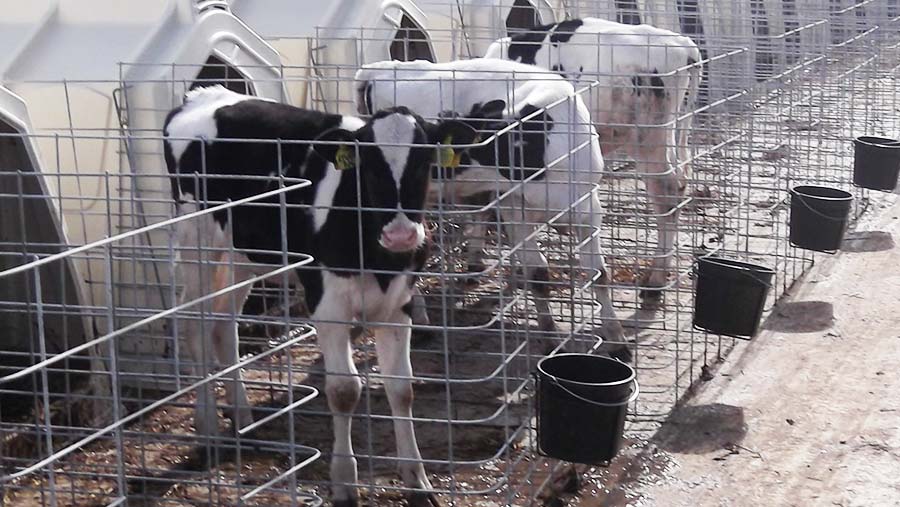Vet Q&A: How to tackle calf scours

Scours is the greatest single cause of death in young calves. Debbie James speaks to vet Mike John of Fenton Veterinary Practice, Haverfordwest, and a farmer who has tackled the disease to find out what can be done to manage the risk.
What is scours and how can it affect calf health?
Calf scours is a clinical sign associated with several diseases characterised by diarrhea. The scouring calf loses fluids and rapidly dehydrates and suffers from electrolyte loss and acidosis. Left untreated, death typically occurs within 24 hours.
What are the main causes of scours?
E coli, cryptosporidium, rotavirus, coronavirus and salmonella. More than one cause is often present. It helps to establish the likely cause as soon as possible because there are excellent specific treatments that can reduce the build up of the pathogen before it reaches dangerous levels.
How can scours be prevented?
Hygiene and feeding colostrum. All prevention measures focus on the prevention of the build up of pathogens in the environment and boosting the calf’s immunity so that it can fight off the infection.
Prompt treatment, isolation of cases, and cleansing and disinfection of pens and all equipment between calves is essential. The calf’s immunity is essentially down to nutrition, particularly colostrum management.
See also: Read more about how to control calf scours by taking our academy
Should I give antibiotics?
Antibiotics are not indicated for most causes of scour in young calves. Oral antibiotics may inhibit the intestines’ natural defences.
Also, they can create resistance in bacteria, which harmlessly live in the calves’ guts, but are dangerous to humans. There are some situations where antibiotics are justified, for example, salmonellosis, and these should be discussed with your vet.
What other treatments might be necessary?
Halofuginone can be effective in the treatment and prevention of cryptosporidiosis. Sometimes faecal samples may indicate that cryptosporidium is the only pathogen involved in the scour and sometimes rotavirus or coronavirus may also be involved.
Halofuginone could be used in both circumstances. The calf might cope with a mild rotavirus infection or a mild cryptosporidiosis infection, but the two often occur together and can be devastating.
How long can I withdraw milk from my calves whilst feeding oral rehydration therapy?
Milk should never be withdrawn for more than 24-hours. If it is, it will starve the calf and create more problems.
It should not be mixed with traditional oral rehydration therapy (ORT) as it disrupts the natural digestion.
In order to both provide enough milk, but also feed enough oral rehydration therapy to avoid dehydration and acidosis.
Feeding three times a day is a good option, particularly for larger calves, providing ORT and milk at different times.
Are there any risks that humans might catch it?
Cryptosporidiosis and Salmonellosis are both zoonoses; diseases which can pass from animals to humans. Therefore, all calves that are scouring should be treated with care.
My neighbour says that they never have a problem with calf scours. Are they telling the truth?
There is a great variety of calf rearing systems. The easiest way of applying changes is to copy someone else who is doing it well. Ask to visit during feeding.
Case study: David and Nicola Renfree, Liskeard, Cornwall
Calf mortalities are under 2% at a Cornish dairy farm after a series of changes were introduced to tackle scours, including increasing the volume of colostrum fed by two litres.
David and Nicola Renfree run the 150-cow pedigree Hayvalley Holstein herd at Quethiock, near Liskeard.
The housed herd, which produces an average milk yield of 10,000kg in two robots, calves all the year round. Three quarters of the herd is bred to sexed semen to produce replacements and surplus stock is sold. The aim is to calve all the heifers at between 22-24 months of age.
See also: Block calving lite improves calf health
Although scours had never been a major problem it did contribute to an overall calf mortality rate of 4%.
Since overhauling the approach to young calf management and increasing the volume of colostrum fed by two litres cases have virtually been eliminated.
Feed regime
Newborn calves are removed from their dam at birth and given a product to improve antibody levels and another to deliver a vitamin and mineral boost.
The dam’s milk is colostrum tested and the calf is tubed with four litres. A further four litres is given four hours later. Calves are placed under heat and when they are dry they are fitted with calf jackets.
“Previously we had fed just as much as a calf would take from a teat and did not test colostrum quality before moving on to tubing everything and feeding six litres,’’ Mr Renfree explains.
They are then reared in calf hutches and fed a bespoke whey-based powder mixed at 150g/litre. This is fed at six litres/calf to give a powder intake of 900g/day, which is achieved by day seven.
Calves then receive straw as a forage and a 6mm nut containing miconized cereals and protein sources. “Once they are eating 1kg a day of this they then move over three days to a 20% protein nut, which we feed ad lib until they eat 3kg a day,’’ explains Mr Renfree who has been working with experts from Nettex to improve youngstock management.
Calves are weaned at 10 weeks and growth rates for the last 12 months have averaged over 0.9kg/day from birth to weaning, compared to the 0.8kg recorded before protocols were changed.
“The use of products to protect calf health plus increasing colostrum usage from four litres to six litres has seen scours reduce by 50%. Mortality for the last 12 months has been under 2% and is in fact currently running at under 1%,’’ adds Mr Renfree.

